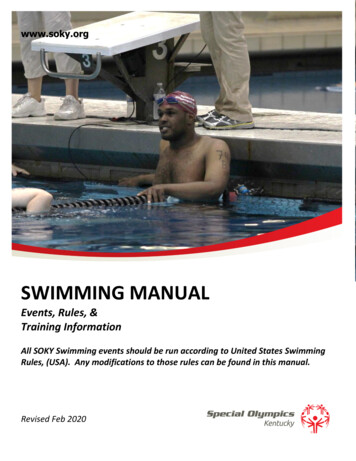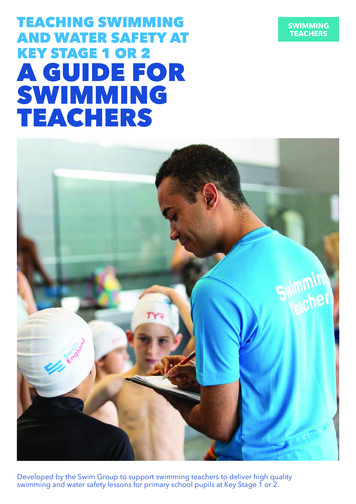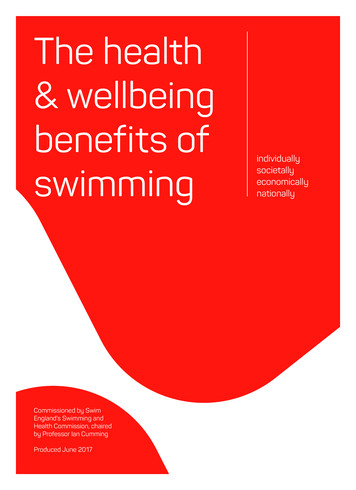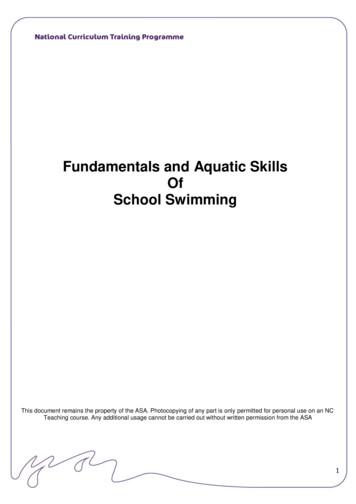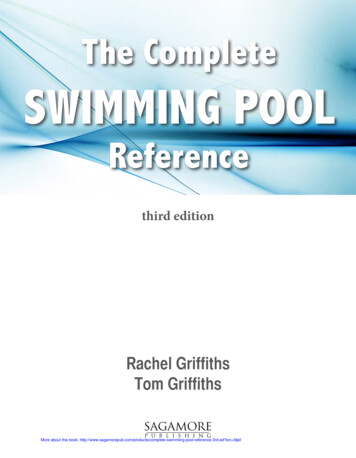
Transcription
STRUČNI ČLANAKUDC: 797.21-055.2DOI: 10.5937/timsact8-64272014. Fakultet za sport i turizam, Novi Sad, TIMS Acta 8, 137-145SWIMMING AS PHYSICAL ACTIVITY AND RECREATIONFOR WOMENMaria Yfanti, Department of Physical Education & Sports Science. Aristotle University ofThessaloniki, GreeceAnastasia Samara, Department of Physical Education & Sports Science. Aristotle University of Thessaloniki, GreecePantelis Kazantzidis, Department of Physical Education & Sports Science. Aristotle University of Thessaloniki, GreeceAnastasia Hasiotou, Department of Physical Education & Sports Science. Aristotle University of Thessaloniki, GreeceSerafeim Alexiou, Department of Physical Education & Sports Science. Aristotle University of Thessaloniki, GreeceAbstractThe present study reviews all data that establish swimming as an everyday lifestyle and ss,well-beingandlongevity.Swimming as a natural, physical activity is one of the most effective ways of exercise, since it affects and work outsthe whole body.It is the most suitable sport for all age groups, because it combines beneficial results, for bothbody and soul and is also a low-risk-injury physical exercise. Aim of this study is to record the effect of recreational swimming in physical condition indexes and in quality of life in women.In particular to record the benefits, since studies have shown that swimming can help in prevention and treatment of chronic diseases and improves quality of life, of well-being and longevity.Results of all studies showed that swimming, as a great natural recreational activity has multiple beneficial effects on the female body that are not limited to the physical characteristics but are extended to the mental ones.Challenges for the application and development fields of this particular method of exercise, are the quality of service provided and the staffing of departments and programs in multiple carriers, private or public.Researchers and writers agree that there are great prospects for growth for women through partnerships, with programs and systematic research in the field of recreational swimming.Keywords: Swimming, Woman, Recreation, Benefits137
Yfanti, M. et al. - Swimming for women2014. Fakultet za sport i turizam, Novi Sad, TIMS Acta 8, 137-145PLIVANJE KAO FIZIČKA AKTIVNOST I REKREACIJA ZAŽENEApstraktOva studija se bavi pregledom svih podataka koji afirmišu plivanje kao deo svakodnevnog životnogstila i rekreativne aktivnosti za žene, budući da promoviše zdrav život, dobrobit i dugovečnost.Plivanje, kao prirodna, fizička aktivnost je jedan od najefektivnijih načina vežbe, jer utiče na celo telo i razvija ga.To je ujedno i najprikladniji sport za sve starosne grupe, jer kombinuje pozitivne efekte na duh i telo, a predstavlja ivežbu sa niskim faktorom mogućnosti povrede. Cilj ovog rada je ispitivanje efekata rekreativnog plivanja na parametrefizičke kondicije i kvaliteta života kod žena.Ovo se pogotovo odnosi na beleženje onih rezultata koji donose boljitak, budući da su studije pokazale da plivanjemože da pomogne u prevenciji i tretmanu hroničnih bolesti, unapređujući kvalitet života, zdravlje i dugovečnost.Rezultati svih istraživanja su pokazala da plivanje, kao odlična prirodna rekreativna aktivnost, ima višestruke pozitivneefekte na žensko telo, koji nisu ograničeni na fizičke karakteristike, već uključuju i mentalne.Izazovi za primenu i razvoj na polju ove konkretne metode vežbanja su kvalitet pružene usluge i adekvatna kadrovskarešenja kompanija i programa, kako javnih, tako i privatnih stejkholdera.Istraživači i autori se slažu u oceni da postoje odlične prilike za razvoj ove discipline za žene, kroz partnerstva saprogramima i sistematskim istraživanjima na planu rekreativnog plivanja.Ključne reči: plivanje, žena, rekreacija, pozitivni efektiTIMS Acta (2014) 8, 137-145IntroductionThe history of swimming is connected with the story of life itself, as the first living creatures of our planetappeared in the primeval oceans before they set foot onland. Moreover, it is well known that every human beingspends its first few months of life in a personal and exclusive aquatic world. Therefore, human attraction to wateris physical and normal for all humans.Data related to swimming date back to in ancienttimes through archaeological findings, proving that inancient Greece swimming was a part of the basic education of children and part of their military education,as well. In ancient Rome there were heated pools. In17th century Japan, swimming was a required course inschool educational programs. People living in Pacific Islands learned to swim before they learned how to walk.Egyptians and Assyrians also indulged in swimming forrecreation and fitness reasons.Swimming was practiced in the Middle Ages as auseful skill for men. Gradually, this activity was thoughtto be a healthy exercise and, afterwards, a recreationalone. In England, swimming, as a sport for all, began tospread during the 17th century. There was a widespreadmovement for improvement of human health, whichgave extra boost to the belief that physical activity wasfavourable for good health (Chase, Sui, & Blair, 2008a).As a result, women were encouraged to change the status of physical inactivity, previously imposed by society.Finally, from the late 19th century, swimming becomes acompetitive sport, but only for men.The benefits of exercise, in people’s physical andmental health, are numerous. Swimming as a physicalactivity can help improve health, physical fitness andquality of life (Saavedra et al., 2007, Fletcher et al., 1996,Gupta & Sawane 2012, Cox et al., 2010, Colado et al.,2009, Kargarfard et al., 2012, Nualnim et al., 2012).138
Yfanti, M.et al. - Swimming for women2014. Fakultet za sport i turizam, Novi Sad, TIMS Acta 8, 137-145Recreational swimming is an activity for all, especially women, mostly during summer and ideal for every age.Due to buoyancy there is no stress on muscles and joints,meanwhile due to water resistance, there is a strengthimprovement for muscles. Swimming, as a sport activity,has many advantages since it combines three basic components: entertainment, physical fitness improvementand lifesaving, in case of an emergency (Hadwen, Arthington, . 2003, Ferretti, De Angelis, Donati & Torre, 2014).Swimming is also a beneficial exercise throughoutthe whole lifetime. The benefits of swimming, especiallyto someone s health are precious and invaluable duringa lifetime. All body muscles are activated. The functionof all systems is improved, especially the general feelingof force, as well as the muscular and cardiovascular endurance.The everyday life of women and their multiple rolesresult to chronic fatigue, bending of energy potential(mental and physical) and the appearance of many diseases such as anxiety, cardiorespiratory disorders, mental disorders etc. It s a strong “escape need” from everyday life the use of free time for kinetic recreation such asswimming sports offer (Berger 1983).Every day stress, fatigue, lack of free time and, perhaps ignorance, lead women to select activities offeredby recreation industry.Even today, the participation of women in sportsis often underrepresented, since it is hampered by social and economic factors in a way that does not occurin men. This prevention remains, despite the obvioushealth benefits that exercise would provide to women,especially in childbearing.Studies have shown that all age groups, from childhood to third age, participating in regular physical activity have better mental, psychological and physical health.The benefits of regular physical activity are plenty, suchas cardiopulmonary endurance, strength increase andimproved body image (Crews and Landers 1987).It is also connected to higher levels of self-esteemand self-confidence and lower levels of anxiety andstress (Iso-Ahola, 1980). Exercise should be a way ofliving and thus it will lead people to live longer, to lookbetter and to be healthier. It is better for a person to exercise throughout the whole life, but it is never too late,thus the ones who exercise harness the benefits of it inany age (Fletcher et al., 1996).The aim of the present study is to review existing articles of the benefits of recreational swimming in women, as well as the motives that lead women to choosethis type of exercise.MethodThe method used in this article is the review ofGreek and foreign literature and articles. The reliabilityand validity of work used in this research is evidenced bythe participation in relevant scientific conferences withevaluation committees and in refereed journals with international circulation.The present work is limited by the following facts:a) part of the literature used consists of summaries ofarticles and studies based on small samples of women,so the data obtained should not be considered representative for the whole population and b) it attempts tohighlight the general model of recreational swimming,targeting women on the basis of the above surveys.Review of studies related to the recreational swimmingin womenPhysical benefits of recreational swimming in general are physical fitness, the improvement of cardiorespiratory and cardiopulmonary system and the endurance ofbody muscles.Physical benefits of recreational swimming in women are: reduction of body weight and heart disease risk,reduction of psychological factors and negative symptoms of menopause, curing the cellulite, improved circulation, protection of women from the growing cancerdiseases.Cardiovascular: Aerobic swimming exercise improvesblood circulation and fights the coronary disease, alsoenhancing the system of oxygen transfer from the lungsto all body cells. (Mohr et al., 2014, Nagle et al, 2013).Musculoskeletal: During the swimming effort, all majorgroup muscles are used. Mainly the arms and upper bodywork more in order to produce the forward movementin relation to the lower limbs of the body. Studies haveshown that exercises in the water depth not exceedingthe loins of a person, decrease joint pressure for up to139
Yfanti, M. et al. - Swimming for women2014. Fakultet za sport i turizam, Novi Sad, TIMS Acta 8, 137-14550%, while exercises in the depth of up to man’s chestdecrease it for up to 75%. Thus, swimming is often usedas a natural rehabilitation exercise after injuries and accidents, while contributing to maintaining joint flexibility,especially in shoulders and hip joints, depending on theswimming technique used. Additionally, swimming is ademanding exercise for all body muscles, making waterexercise much more effective than land exercise. Musclestrengthening occurs due to the resistance of water inevery direction, which helps muscles to be exercised, depending on the speed the various exercises are executed. Exercise in water provides the body with 12 to 14%higher resistance than land exercise, resulting in higherconsumption of calories. Moreover, water resistanceprotects muscles from jerky body movements, which arehighly connected to sport injuries (Pons-Villanueva et al.,2010, Collado et al., 2009).Flexibility: Swimming can significantly improve one sflexibility. The smoothness of movement helps to lengthen and stretch the muscles of the body, rather than tobecome bulky, making them seem toned, healthy andstrong. Such a program must be based on the general development of body flexibility and gradually expand intospecific joints, with the aim of increasing the final limitof joints (Valkeinen et al., 2004). Exercise should nevercreate muscular pain on specific joints; on the contrary,it should reduce the risk of injury by lowering stress.Obesity: Exercise in water has many advantages forobese people. It contributes in a rise of energy expenditure, in easier weight control and in lessening of overloadon joints and muscles due to buoyancy. Thus, the energy expenditure increases, the muscle mass is preservedand the fat tissue is reduced. Swimming also helps reducing systolic blood pressure (by 4,7 mmHg), increasingthe tissue sensitivity to insulin and improving the bloodglucose control (Cox et al., 2010). Reasons mentionedabove, result to morbidity and mortality reduction ofobese people (Gappmaier et al., 2006, Cox et al., 2010,Jones et al., 2009).Mental benefits, swimming and mental healthFindings of epidemiological studies and specializedanalyses show that the individuals who exercise regularly, are less prone to depression and have lower anxietylevels, compared to sedentary ones (Wade 1985). Meanwhile, these persons display an active behaviour. Exercising contributes to a better body image, self-esteemand self-perception, feeling of achievement, of superiority and realisation (Michevic 1982). This is due to variations caused to sympathetic system activation, as wellas to various physiological alterations (Crews & Landers,1987). Anxiety reduction through physical exercise, depends on the intensity of the exercise. Results of different studies have shown that aerobic exercise contributesmore to anxiety reduction, due to elimination of fear ofwater, enhances water confidence and helps in socialization when exercising in groups. Berger & Owen (1983)observed that people who participated in swimming lessons significantly enhanced their emotions. In general,types of exercise suggested by researchers are walkingfirst and swimming afterwards. It is known that duringaerobic swimming endorphins are released, one of thethree main groups of endogenous opioids produced inbrain, with best known the beta-endorphin, acting withstrongest analgesic action. Group exercise, either aerobic in water or regular exercize on land, can help peopleto socialize. Exchange of stories, mutual challenge, thefeeling of sharing a “hard” exercise, makes training a rewarding experience (Lee and Oh, 2013).Quality of life measurement instrumentsThe first attempts to define quality of life started in1970’s. Since then, constant efforts have been made tocreate various different methods of measuring quality oflife. The instruments created are divided in two categories (Amarantos, Martinez & Dwyer, 2001): Generic instruments or general toolsThese tools were created to measure quality of lifeand health level of the general population, as well as thatof different socio-economic and cultural groups. Theseinstruments can be used in various situations. Disease-specific instruments.These instruments are related to the measurementof life quality in a population with specific diseases andspecific disease categories. They are used in particularoccasions and focus on specific health problems, not onlyphysical but also mental, caused by specific diseases.140
Yfanti, M.et al. - Swimming for women2014. Fakultet za sport i turizam, Novi Sad, TIMS Acta 8, 137-145Participation motives - Differences in motives betweenmen and womenNumerous studies have been published studyingmen and women motives in choosing different sports.According to Biener (1980), women, more often thanmen, are motivated to sports. Men are influenced byextraneous incentives while women are influenced byinternal ones. Additionally, men are not motivated bywomen to exercise, while the opposite happens muchmore often (Biener, 1980, Meyer, 1992) According toMeyer, health is the number one reason in motivationscale for women. Heuwinkel (1990), on the other hand,finds a significant difference in appreciating “wellness”in women (85%) compared to men (55%). According toOpaschowski (1987), body image is much more important in women, 26%, in contrast to men, 6%. It is ratherobvious that motives such as, health and good fitness,stress reduction, companionship, good performance andappearance are dominant in women’s minds (Cox et al.,2008). Another study results in the same conclusion;women in comparison to men think that exercise is agood chance to achieve balance between exterior workand housework. Women’s percentage was 78,3 andmen’s 70,5 (Meyer,1992). Finally, according to Emnid’ssurvey, the “health” motive is mentioned first, with goodphysical condition and appearance coming second andanxiety control, third.In a survey conducted by the Department of Epidemiology at the University of North Carolina, U.S.A,in 9953 pregnant women, it was found that 12% havechosen swimming as an exercise medium (Zhang, Savitz,1996). The most popular activities recorded in a similarresearch, were walking, aerobics and swimming, (Hartmann, & Bung, 1999).Basic advantages of physical exercise for pregnantwomenSwimming has plenty of benefits for women duringpregnancy, such as relief of back pain, reduction of constipation and swelling of lower limbs, prevention or treatment of gestational diabetes mellitus, increased energylevels, improved disposition (reduces anxiety and stressconcerning pregnancy outcome), improves posture (decreases back ache), stimulates muscle tone, strength, endurance and muscle elasticity, improves quality of sleep,reduces cardiovascular stress, helps pregnant womengive birth to healthy and well developed babies and finally improves rehabilitation after labor (Clap & Little,1995, Sibley et al., 1981).Due to buoyancy, swimming is the ideal exerciseduring pregnancy. The additional weight is supported bywater and makes exercise easier and safer to the woman and baby, protecting both from injuries (Hartmann &Bung, 2005).Swimming during pregnancyNecessary precautionsWhile many forms of exercise are commonly considered too aggressive and therefore not recommendedduring pregnancy, swimming has a very unique profilecompared to most other regimens. Swimming offers asafe means of exercising as the water partially supportsbody weight, decreasing burden on spine and limbs. Asa low impact exercise, it helps muscle strengthening, improves the function of cardiovascular system and makesoxygen delivery to the baby easier and more effective.Swimming can lower stress level during pregnancy andhelp women sleep better. It can also help women reduceunhealthy habits such as smoking, increased alcohol intake, too much stress at work, etc. (Clap & Little, 1995,Sibley et al., 1981, Juhl, et al., 2010, Katz, 1996).Although swimming is a safe and effective type of exercise, there are always some necessary precautions toconsider, such as: not all exercise training programs aresuitable for every woman but “custom-made” sessionsshould be considered, depending on the level of physical fitness of the person. It is important to plan feasibleexercise programs in water. There should also be regularweight control and arterial pressure checking, as well asencouragement and discussion on the objectives and results of the program (Katz, 1996, Juhl et al., 2010).141
Yfanti, M. et al. - Swimming for women2014. Fakultet za sport i turizam, Novi Sad, TIMS Acta 8, 137-145Discussion - conclusionThe main findings of this review were:Regular and programmed activity in water reflectspositively on all systems of the exercising women s bodies (Fletcher et al., 1996). It causes qualitative and quantitative increase of function, increased efficiency andimproved operational systems (Zinman et al., 1986, Pherwani, et al., 1988, Courteix et al., 1997). Swimming cantrain the whole body, the heart, the lungs and muscles,having minimum bad impact on joints and ligaments (Rodriguez, 2000). Therefore, an athlete could get a healthybody by swimming only. Due to the physical propertiesof water (buoyancy, hydrostatic pressure, resistance andtemperature) the possibilities of a safe and effective exercise activity are numerous, even in comparison withthe land exercise ( Potdevin, Normani & Pelayo, 2013)It is equally suited for small children and the elderly.Inside the pool, body weight is balanced by the buoyantforce of water. Also, the hydrostatic pressure makes theblood circulation easier. This is why water-based exercises are recommended to those with physical disabilitiestoo, since the exercise program can be adjusted to eachindividual. (Costil, Maglisco & Richarson, 1992, Doherty,& Dimitriou, (1997).).Furthermore, this activity engages nearly everymuscle in the body. Improving blood circulation helps toremove small layers of cholesterol or other toxins within the blood vessels and to improve the cardiovascularfunction. Also, swimming requires a large number of calories per stroke. This includes calories from the cholesterol, as the leading cause of heart-related illnesses andelevated blood pressure (Deligiannis., Bakirtzi, Zaxopoulou & Giatsis, 1989).Swimming as a recreational activity has many advantages for women, not only physically, but also mentally.When exercising becomes a way of lifestyle, it hindersthe onset of symptoms of old age and activates the psychic potential, improving the quality of life. Many studiesconfirm that water-based exercise, as a physical activity,can contribute to not only the formation and improvement of one’s personality but also to increase of perception and appreciation for oneself through the overalleffect on physical and psychological well-being (Papaioannou, 1997, Whitehead & Corbin, 1997).As revealed by the reviews of motives for participation, women are motivated by internal incentives andparticularly the purpose of improving their physical andmental health, resulting in better fitness and better dealing with everyday responsibilities. Other factors can be,for example, the improvement of self-image, as well asthe stress reduction. Socialization, after all, through recreational swimming programs, can contribute to bettermental health (Meyer, 1992).External motives can be free time, the socio-economic way of life, and the existing recreational programs,with the quality of sport facilities. Finally, for women,the bodily fatigue, the achievement of personal goals,the personal satisfaction and pleasure are importantreasons for participating in recreational swimming. Thisactivity helps developing life skills, such as love for sport,proper time management, self-discipline, learning to setlife-goals as well as developing the sense of self-validitythrough sport participation.In general, the researchers agree that there aregreat prospects for development through partnerships,programs and systematic study of this level of swimming.One of the most important periods in woman’s life istime during pregnancy. Since all scientists agree on thebeneficial effect of exercise even during pregnancy, it isa matter of personal preference for the mother-to-be toinclude movement and physical exercise in daily routine.It is extremely important for a woman to pass throughthese nine months as normal and uncomplicated as possible. Regular aerobic exercise, such as swimming, canresult in significant improvement in physical fitness andspecific in aerobic capacity, meanwhile contributing tomaintaining healthy body weight.In addition, water birth has been suggested as a particularly safe and natural method and has been appliedin several obstetric clinics, even in Greece.Swimming helps counteract the increased backstrain from expanding belly. Pregnancy forces the spineand shoulders to round forward and the pelvis to tilt outof alignment. Swimming can gently strengthen the muscles and offset this tendency. The water also protectsfrom overheating and supports joints and ligaments, preventing injury, lowering arterial pressure and preventingpregnancy diabetes (Lewis, et al., 2008). In a Valgesoo &Linkberg (1997) research, 149 healthy pregnant women142
Yfanti, M.et al. - Swimming for women2014. Fakultet za sport i turizam, Novi Sad, TIMS Acta 8, 137-145were divided to three exercise groups. The first groupfollowed a 4-month yoga exercise program, the secondgroup practiced energetic exercise and the third grouppracticed swimming, (20 minutes per training, intensityto the 62% of maximum heart rate). All three groups hadnormal birth, free of complications, with the 2nd and 3rdgroup having better physical fitness, a fact that helpedwomen gain less weight (2 kilos) and babies to be born alittle lighter (200 gr) compared to 1st group.Marquez-Sterling et al (2000) suggested a low impact aerobic exercise programme. In their research, 149pregnant women who used to train took part in a program including aerobic, walking, swimming, stationarybicycle and stationary rowing. The duration of the programme significantly affected their aerobic capacity andthey had a normal birth delivery.SuggestionsThe possibility for recreation and exercise, the sportfacilities and employment of efficient staff in sports unitsconstitute important steps towards the qualitative upgrading of the sport recreation. It is important that further research concerning female engagement in sports,particularly in swimming, be done, starting from recreation and health preservation, as well as at pregnancystages, when the phoetus grows inside the moist environment of its mother’s abdomen.According to Mull, Bayless, Ross and Jamieson(1997), at the recreation sports area, there is an extended range of activities, the same one should be applied torecreation swimming.Participation in regular swimming programs of public and private entities is important, as well as in generalprograms like “sport for all” where participants take partfor fun and good health, just for the joy of participation.Also participation in tournaments of entities like universities, clubs and business corporations.The following should be also considered:Creation of groups depending on the capability ofthe participants, improvement of the program when theinitial target is achieved, appropriateness of sport facilities, suitable training hours especially for mothers, childcare for special occasions etc.REFERENCESAmarantos, E., Martinez, A., & Dwyer J. (2001). Nutrition and quality oflife in older adults. Journal of Gerontology and Biological Scienceand Medicine Science. 56(2), 54-64.Berger, B.G., & Owen, D.R. (1983). Mood alteration with swimmingswimmers really do «feel better». Psychosomatic Medicine. 45(5),425-33.Biener, K. (1980). Repraesentativ studie ueber das Sportverhalten unddas Sportinteresse berusfstaetiger Frauen. In:Jugend und Sport.Chase, N.L., Sui, X., & Blair, S.N. (2008a). Comparison of the healthaspects of swimming with other types of physical activity andsedentary lifestyle habits. International Journal of AquaticResearch & Education. 2(2), 151-161.Clapp, J.F., 3d, Little, K.D. (1995). Effect of recreational exerciseon pregnancy weight gain and subcutaneous fat deposition.Medicine and Science in Sports Exercise. 27, 170-177.Colado, J.C., Triplett, N.T., Tella, V., Saucedo, P., & Abellán, J. (2009).Effects of aquatic resistance training on health and fitness inpostmenopausal women. European Journal of Applied Physiology.106(1), 113-22.Costil, DL, Maglisco, E.W., & Richarson, A.B. (1992). Handbook of sportsmedicine and science swimming. Malden Blackwell Science Ltd.Courteix, D., Obert, P., Lecoq, A. M., Guenon, P., & Koch, G. (1997).Effect of intensive swimming training on lung volumes, airway resistances and on the maximal expiratory flow-volume relationshipin prepubertal girls. European journal of applied physiology andoccupational physiology. 76(3), 264-269.Courteix C., Coudore, M.A., Eschalier A., Fialip J., Jajac, J.M., LavarenneJ CI988, (1997). An antagonist of cholecystokinin type B receptorand 1DMe, an analogue of neuropeptide FF, enhance the analgesic effect of morphine in diabetic rats. British Journal of Pharmacology. 122 (3), 35P.Cox, K.L, Burke, V., Beilin, L.J., & Puddey, I.B. (2010). A comparison ofthe effects of swimming and walking on body weight, fat distribution, lipids, glucose, and insulin in older women--the SedentaryWomen Exercise Adherence Trial 2. Metabolism. 59(11),15621573.Cox, K.L., Burke, V., Beilin, L.J., Derbyshire, A.J., Grove, J.R., Blanksby,B.A., & Puddey, I.B. (2008). Short and long-term adherence toswimming and walking programs in older women--the SedentaryWomen Exercise Adherence Trial (SWEAT 2). Preventive Medicine.46(6), 511-517.Crews, D.J, & Landers, D.M., (1987). A meta-analytic review of aerobicfitness and reactivity to psychosocial stressors. Medicine and Science in Sports Exercise. 19(5), 114-120.Deligiannis A., Bakirtzi E., Zaxopoulou E., & Giatsis, S.(1989). The effectsof swimming on cardiac morphology and Function. Medicine Science and Research. 17, 97-98.Doherty, M., & Dimitriou, L. (1997). Comparison of lung volume inGreek swimmers, land based athletes, and sedentary controlsusing allometric scaling. British journal of sports medicine, 31(4),337-341.Ferretti E., De Angelis, S., Donati, G., Torre, M. (2013). Fatal and non-fatal unintentional drownings in swimming pools in Italy: Epidemiological data derived from the public press in 2008–2012. Microchemical Journal. 113, 64-68.Fletcher, G.F., Balady, G., Blair, S.N., Blumenthal, J., Caspersen, C.,Chaitman, B., Epstein, S., Sivarajan, Froelicher, E.S, Froelicher, V.F.,Pina, I.L, & Pollock, M.L. (1996). Statement on exercise: benefitsand recommendations for physical activity programs for all Amer-143
Yfanti, M. et al. - Swimming for women2014. Fakultet za sport i turizam, Novi Sad, TIMS Acta 8, 137-145icans. A statement for health professionals by the Committee onExercise and Cardiac Rehabilitation of the Council on Clinical Cardiology. American Heart Association. Circulation. 94(4), 857-862.Gappmaier, E., Lake, W., Nelson, A.G., & Fisher, A.G. (2006). Aerobicexercise in water versus walking on land: effects on indices offat reduction and weight loss of obese women. Journal of SportsMedicine and Physical Fitness. 46(4), 564-569.Gupta, S.S., & Sawane, M.V. (2012). A comparative study of the effectsof yoga and swimming on pulmonary functions in sedentary subjects. International Journal of Yoga. 5(2), 128-133.Hadwen, W.L., Angela H., Arthington A.H. & Thorsten D. (2003). Theimpact of tourism on dune lakes on Fraser Island, Australia. Lakesand Reservoirs. 8(1), 15–26Hartmann, S. & Bung, P. (1999). Physical exercise during pregnancy-physiologica
and lifesaving, in case of an emergency (Hadwen, Arth-ington, . 2003, FerrettiDe Angelis, , Donati & Torre, 2014). Swimming is also a beneficial exercise throughout the whole lifetime. The benefits of swimming, especially to someone s health are precious and invaluable during a lifetime. All body muscles are activated. The function



